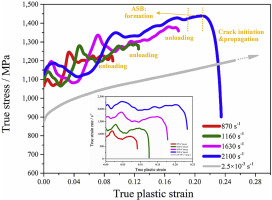当前位置:
X-MOL 学术
›
Prog. Nat. Sci. Mater. Int.
›
论文详情
Our official English website, www.x-mol.net, welcomes your feedback! (Note: you will need to create a separate account there.)
Mechanical behavior of a near α titanium alloy under dynamic compression: Characterization and modeling
Progress in Natural Science: Materials International ( IF 4.7 ) Pub Date : 2019-08-01 , DOI: 10.1016/j.pnsc.2019.07.001 Xiaohui Shi , Cong Zhao , Zuhan Cao , Tuanwei Zhang , Zhihua Wang , Junwei Qiao
Progress in Natural Science: Materials International ( IF 4.7 ) Pub Date : 2019-08-01 , DOI: 10.1016/j.pnsc.2019.07.001 Xiaohui Shi , Cong Zhao , Zuhan Cao , Tuanwei Zhang , Zhihua Wang , Junwei Qiao

|
Abstract Dynamic compression tests under strain rates from 870 s−1 to 2100 s−1 were conducted for a near α Ti–8Al–1Mo–1V titanium alloy with equiaxed microstructure. Compression behavior, adiabatic shearing and band microstructure were investigated via characterization and calculation. The results demonstrate that all dynamic constitutive curves exhibited obvious stress fluctuation phenomenon with double increase-decrease changing stages at the primary stage of compression. The dislocation multiplication theory can be used to explain this phenomenon. After the stress fluctuation period, work hardening coexisted with the thermal softening, resulting in the slow hardening tendency in constitutive curves. J-C model was utilized to quantify the dynamic constitutive curves. The deviations between the predicted and experimental curves under high strain rates may be attributed to the over-consideration of thermal softening effect in J-C model. Adiabatic shearing band (ASB) began to form under the strain rate of 2100 s−1. A total shearing strain of 8.1 within ASB achieved in 8.9 μs, corresponding to a local strain rate of about 9.1 × 105 s−1 and is over 430 times of the macro strain rate. Post annealing was conducted on ASB before EBSD characterization. Due to the static recrystallization during annealing, the α phase within ASB generally presented as ultra-fine grains less than 1 μm in diameter.
中文翻译:

动态压缩下近α钛合金的力学行为:表征和建模
摘要 对具有等轴显微组织的近α Ti-8Al-1Mo-1V 钛合金进行了870 s-1 至2100 s-1 应变速率下的动态压缩试验。通过表征和计算研究了压缩行为、绝热剪切和带微观结构。结果表明,在压缩初级阶段,所有动态本构曲线均表现出明显的应力波动现象,呈双增减变化阶段。位错倍增理论可以用来解释这种现象。应力波动期过后,加工硬化与热软化并存,导致本构曲线出现缓慢硬化趋势。JC 模型用于量化动态本构曲线。高应变率下预测曲线与实验曲线之间的偏差可能是由于在 JC 模型中过度考虑了热软化效应。在 2100 s-1 的应变速率下开始形成绝热剪切带 (ASB)。在 8.9 μs 内实现 ASB 内 8.1 的总剪切应变,对应于约 9.1 × 105 s-1 的局部应变率,是宏观应变率的 430 倍以上。在 EBSD 表征之前对 ASB 进行后退火。由于退火过程中的静态再结晶,ASB中的α相一般表现为直径小于1μm的超细晶粒。9 μs,对应于约 9.1 × 105 s-1 的局部应变率,是宏观应变率的 430 倍以上。在 EBSD 表征之前对 ASB 进行后退火。由于退火过程中的静态再结晶,ASB中的α相一般表现为直径小于1μm的超细晶粒。9 μs,对应于约 9.1 × 105 s-1 的局部应变率,是宏观应变率的 430 倍以上。在 EBSD 表征之前对 ASB 进行后退火。由于退火过程中的静态再结晶,ASB中的α相一般表现为直径小于1μm的超细晶粒。
更新日期:2019-08-01
中文翻译:

动态压缩下近α钛合金的力学行为:表征和建模
摘要 对具有等轴显微组织的近α Ti-8Al-1Mo-1V 钛合金进行了870 s-1 至2100 s-1 应变速率下的动态压缩试验。通过表征和计算研究了压缩行为、绝热剪切和带微观结构。结果表明,在压缩初级阶段,所有动态本构曲线均表现出明显的应力波动现象,呈双增减变化阶段。位错倍增理论可以用来解释这种现象。应力波动期过后,加工硬化与热软化并存,导致本构曲线出现缓慢硬化趋势。JC 模型用于量化动态本构曲线。高应变率下预测曲线与实验曲线之间的偏差可能是由于在 JC 模型中过度考虑了热软化效应。在 2100 s-1 的应变速率下开始形成绝热剪切带 (ASB)。在 8.9 μs 内实现 ASB 内 8.1 的总剪切应变,对应于约 9.1 × 105 s-1 的局部应变率,是宏观应变率的 430 倍以上。在 EBSD 表征之前对 ASB 进行后退火。由于退火过程中的静态再结晶,ASB中的α相一般表现为直径小于1μm的超细晶粒。9 μs,对应于约 9.1 × 105 s-1 的局部应变率,是宏观应变率的 430 倍以上。在 EBSD 表征之前对 ASB 进行后退火。由于退火过程中的静态再结晶,ASB中的α相一般表现为直径小于1μm的超细晶粒。9 μs,对应于约 9.1 × 105 s-1 的局部应变率,是宏观应变率的 430 倍以上。在 EBSD 表征之前对 ASB 进行后退火。由于退火过程中的静态再结晶,ASB中的α相一般表现为直径小于1μm的超细晶粒。


























 京公网安备 11010802027423号
京公网安备 11010802027423号